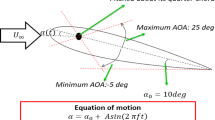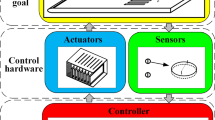Abstract
In this paper the design and application of a control algorithm is discussed to control the test conditions within plenum chamber and the test section of a supersonic blow-down, variable throat wind tunnel at the University of Alabama. The artificially intelligent controller algorithm was designed using a gain scheduled Proportional-Integral-Differential (PID) control approach. The PID controller was augmented to work with time variant properties of the control problem by determining a functional form of the integral term of the controller from the governing equations of the tunnel. The controller was optimized using genetic algorithms (GA) on a neural network (NN) model of the tunnel and was compared to a conventional PID controller using the same NN model. The process was repeated for different throat settings to find the control gains for each setting. The controller algorithm was next applied to the actual wind tunnel at different throat settings and the results were compared. The optimized controller is proven to work very well at every throat setting.
Similar content being viewed by others
References
Hwang D-S, Hsu P-L (1998) A robust controller design for supersonic intermittent blow down type wind tunnels. Aeronaut J Roy Aeronaut Soc 102(1013):161–169
Zhang G, Chai T, Shao C (1997) A synthetic approach for control of intermittent wind tunnel. In: Proceedings of the American control conference, Albuquerque, NM, June 1997
Miwa H, Sato M, Sakakibara S, Takashima K (1986) Closed-loop Mach number control and measurement. In: Fluid control and measurement; proceedings of the international symposium, Tokyo, Japan, 2–5 September 1985, pp 515–520
van Zanten R, Wind tunnel control by compactRio. http://www.citengineering.com/downloads/pdf/TUDelft_Eng.pdf
Matsumoto J, Lu F, Wilson D (2001) Preprogrammed controller for a supersonic wind tunnel, AIAA 2001-1056. In: 39th AIAA aerospace sciences meeting and exhibit, Reno, NV, 8–11 January 2001
Motter M, Principe J (1997) Neural control of the NASA Langley 16-fott transonic tunnel. In: Proceedings of the American control conference, Albuquerque, NM, June 1997
Ogata K (2001) Modern control engineering, 4th edn. Prentice-Hall, New York
Wu C-J (1999) Genetic tuning of PID controllers using a neural network model: a seesaw example. J Intell Robot Syst 25:43–59
An E-S, Lee D-H, Jeon C-M, Kim I-H, Park C-W (2003) System identification and two DOF PID controller design for an industrial sewing machine. IECON Proc 2:1557–1563
Holland JH (1975) Adaptation in natural and artificial systems. University of Michigan Press, Ann Arbor
Karr C (1999) Practical Implications of computational intelligence for adaptive control. CRC Press, Boca Raton. ISBN 0-8493-2069-0
McMichael J, Parekh D, Heiges M 2004 The application of fuzzy methods and genetic algorithms to flow control, AIAA-2004-2524. In: 2nd AIAA flow control conference, Portland, OR, 28–31 June 2001
Bedwani WA, Ismail OM (2001) Genetic optimization of variable structure PID control systems AICCSA. In: ACS/IEEE international conference on computer systems and applications (AICCSA’01), p 27
Saravanan N, Duyar A, Guo T-H, Merrill WC (1994) Modeling space shuttle main engine using feed-forward neural networks. J Guid Control Dyn 17(4):641–648
Rosario RA, Steinle FW Jr (2002) Neural network application for optimizing multi-stage wind tunnel compressor efficiency, AIAA-2002-308. In: 40th AIAA aerospace sciences meeting and exhibit, Reno, NV, 14–17 January 2002
Jacobs JH (ed) (2000) Active control of wind-tunnel model aeroelastic response using neural networks. In: Smart structures and materials 2000: Industrial and commercial applications of smart structures technologies, June 2000. Proceedings of SPIE, vol 3991, pp 232–243
Suzuki S, Sakamoto Y, Sanematsu Y, Takahara H (2005) Analysis of human pilot maneuver using neural network combined with genetic algorithms, AIAA-2005-910. In: 43rd AIAA aerospace sciences meeting and exhibit, Reno, NV, 10–13 January 2005
Sejnowski T, Rossenburg C (1987) Parallel networks that learn to pronounce English text. Complex Syst 1:145–168
Luge GF (2002) Artificial intelligence—structures and strategies for complex problem solving, 4th edn. Addison–Wesley, Reading. ISBN 0-201-64866-0
Wasserman PD (1989) Neural computing—theory and practice, Van Nostrand and Reinhold, New York, p 18
Bishop CM (1995) Neural networks for pattern recognition, Oxford University Press, Oxford, p 77
Author information
Authors and Affiliations
Corresponding author
Rights and permissions
About this article
Cite this article
Nott, C.R., Ölçmen, S.M., Lewis, D.R. et al. Supersonic, variable-throat, blow-down wind tunnel control using genetic algorithms, neural networks, and gain scheduled PID. Appl Intell 29, 79–89 (2008). https://doi.org/10.1007/s10489-007-0082-y
Received:
Accepted:
Published:
Issue Date:
DOI: https://doi.org/10.1007/s10489-007-0082-y




